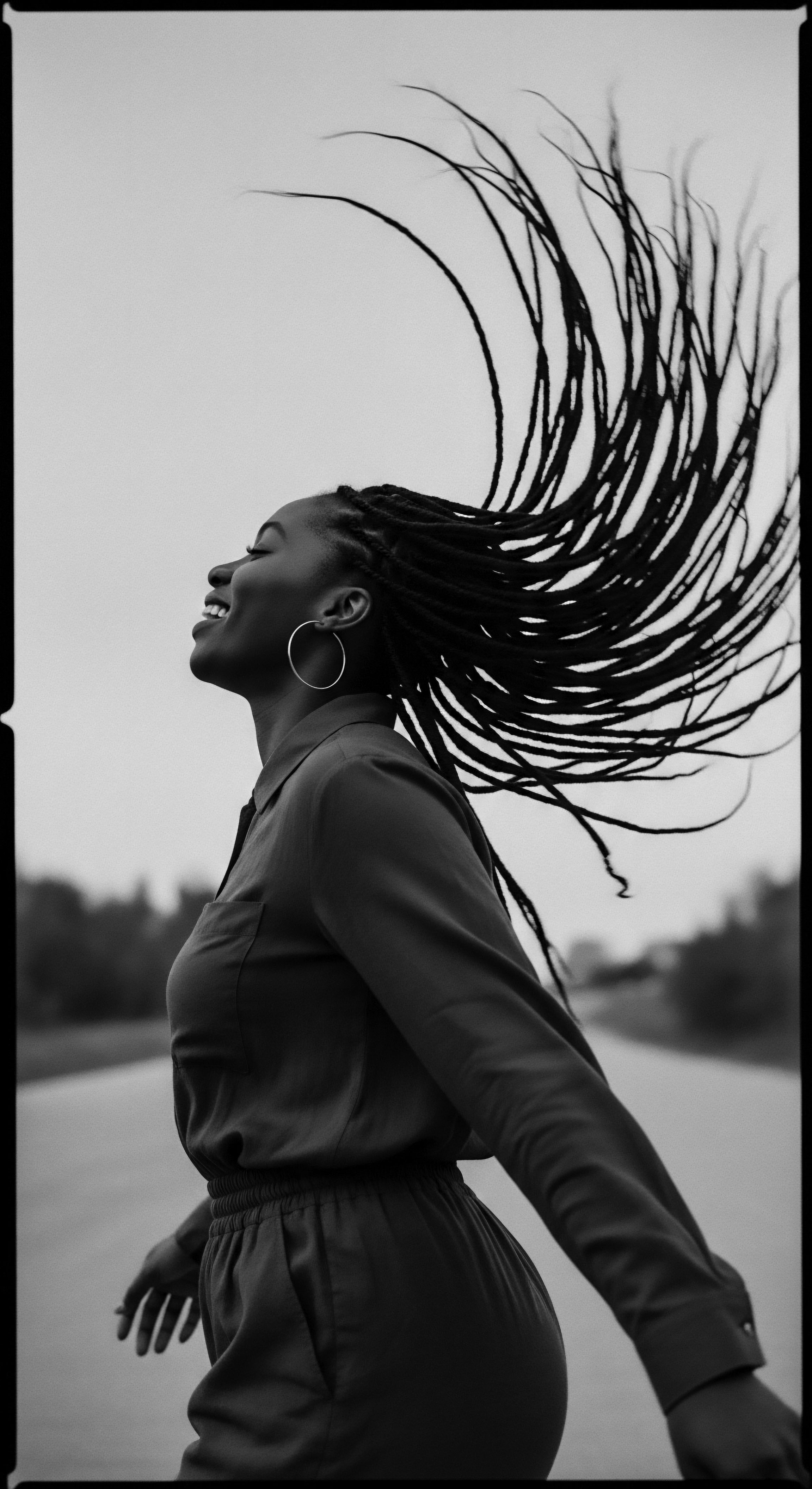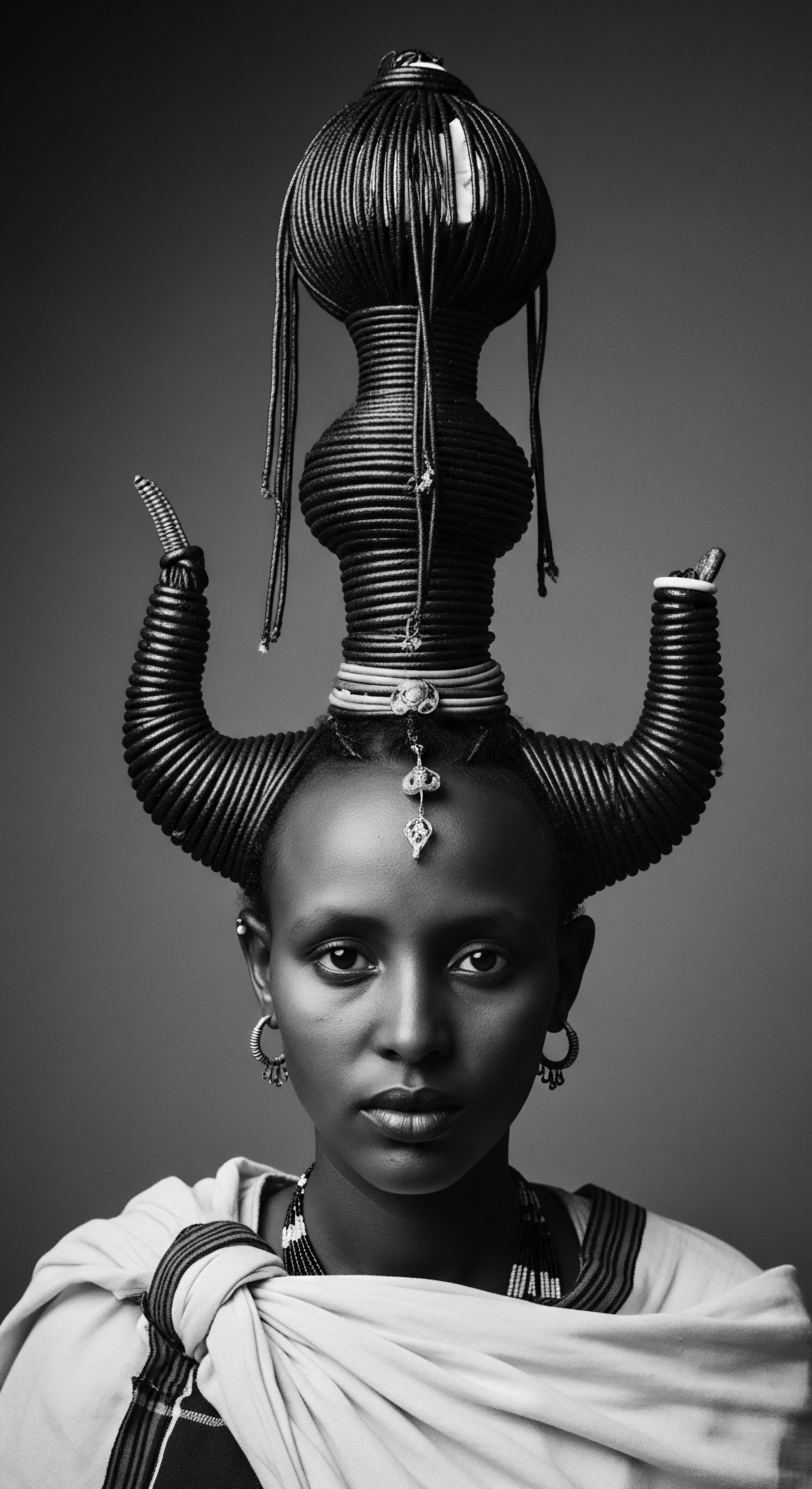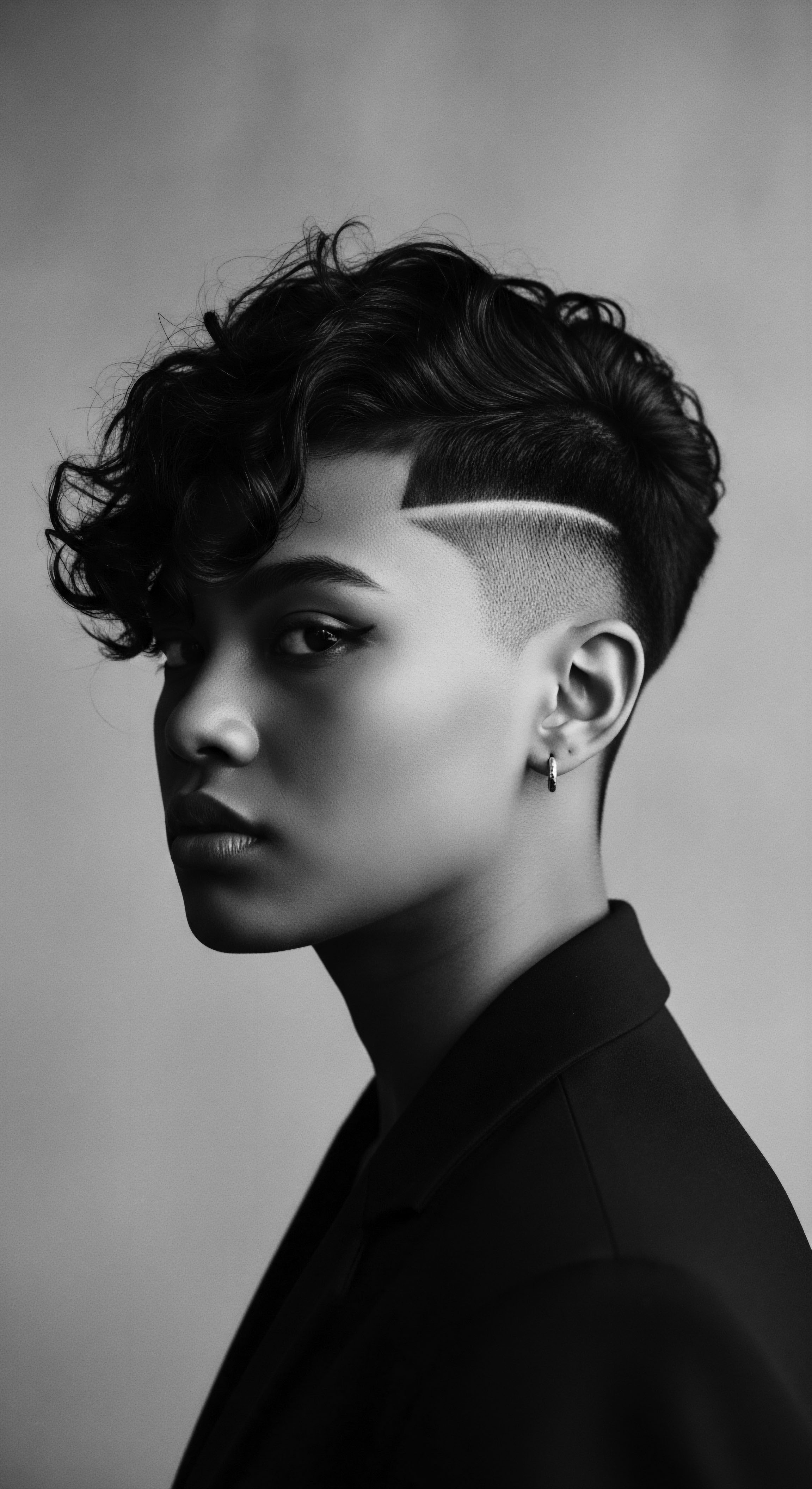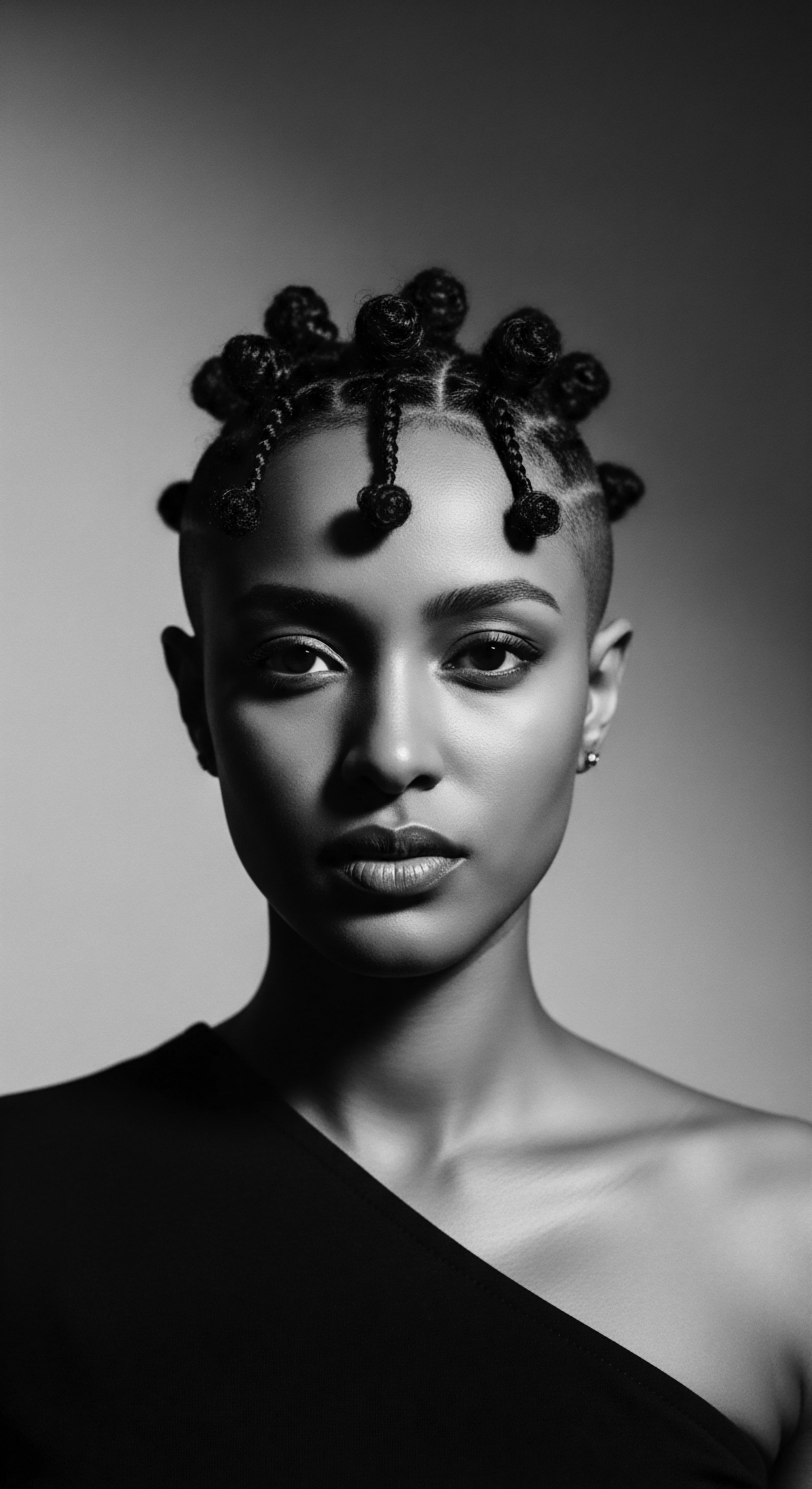
Roots
The very strands that crown our heads, particularly those with the glorious curl and coil, carry a lineage as old as time, a heritage etched into their very helix. To speak of textured hair is to speak of identity, of resilience, of an unbroken chain linking us to ancestral wisdom and practices. The protection of this hair, then, becomes far more than a mere cosmetic concern; it transforms into a fundamental civil right, a claim to selfhood that has, for far too long, been denied or diminished. It is a declaration that the essence of who we are, manifest in the very fabric of our being, warrants safeguarding.
This journey into understanding why textured hair protection rises to the stature of a civil right begins at the source—the elemental biology that gives these strands their unique character, interwoven with the ancient understandings that have guided their care for millennia. We are not just discussing fibers, but living extensions of history, culture, and spirit.

What Constitutes the Anatomy of Textured Hair?
At its fundamental level, the architecture of textured hair, often characterized by its spirals and zigzags, differs remarkably from its straighter counterparts. Its elliptical follicle shape, a distinguishing feature, dictates the formation of curls. This shape, unlike the round follicle of straight hair, causes the hair to grow in a more complex, undulating pattern.
Moreover, the distribution of keratin, the protein that forms the hair shaft, is unevenly dispersed, creating points of weakness along the bends and curves. These unique structural elements make textured hair more susceptible to dryness and breakage, demanding a particular kind of attunement and care.
For generations, before the advent of modern scientific tools, ancestral communities held an intuitive comprehension of these delicate structures. Their practices, passed down through oral tradition and lived experience, were a testament to empirical observation and a profound connection to the body’s natural rhythms. They understood the need for gentle handling, for rich emollients drawn from the land, and for styles that honored the hair’s natural inclination. This traditional knowledge, honed over countless seasons, forms an ancient scientific heritage.
The protection of textured hair is not a modern innovation but a deep-seated claim to identity, rooted in the very fibers that have long carried the echoes of ancestral wisdom.

How Have Ancestral Communities Classified Hair?
While contemporary systems of hair classification, such as those categorizing hair by number and letter (e.g. 3A, 4C), are relatively recent constructs, born from a desire for systematic understanding and product marketing, historical and ancestral communities engaged in their own profound categorizations. These were rarely rigid scientific frameworks, but rather rich, cultural lexicons deeply embedded in identity and societal roles.
In many African societies, hair was not simply an aesthetic feature; it was a potent symbol of status, tribe, marital status, age, and even spiritual connection. Hair was often categorized by its texture, length, and how it could be styled into complex forms. For example, specific braiding patterns or intricate coiffures might signify a woman’s readiness for marriage or a man’s leadership role within the community. These classifications were not about grading hair on a linear scale of “good” or “bad,” but about recognizing its distinct characteristics and its role in communal narrative and individual expression.
- Yoruba Aesthetics ❉ Elaborate braiding and threading styles (like ‘irun didi’ or ‘shuku’) denoted social standing, ritual significance, or even mourning, reflecting diverse textures and their adaptability.
- Maasai Practices ❉ Warriors’ red-ochred braids signified strength and virility, a practice that works uniquely with coily textures to hold the form and color.
- Fulani Braids ❉ Characterized by a central plait and intricate side braids, often adorned with cowrie shells and beads, reflecting the hair’s capacity for such detailed, protective styles.
The very language used to describe textured hair in these traditions was often poetic and respectful, unlike some of the pejorative terms that emerged from colonial encounters. Hair was seen as a connection to the divine, a conduit for spiritual energy, and a crown to be honored. This inherent reverence laid the groundwork for care rituals that were deeply protective, understanding that damage to the hair was, in a sense, a diminishment of the self and one’s communal standing.
| Aspect of Categorization Primary Purpose |
| Ancestral Context (Pre-Colonial African) Social, spiritual, identity, communal roles |
| Modern Context (Post-20th Century) Styling, product recommendations, scientific study |
| Aspect of Categorization Basis of Distinction |
| Ancestral Context (Pre-Colonial African) Cultural significance, style potential, visible characteristics |
| Modern Context (Post-20th Century) Curl pattern, density, porosity, width of strand |
| Aspect of Categorization Underlying Philosophy |
| Ancestral Context (Pre-Colonial African) Reverence, celebration of diversity, holistic connection |
| Modern Context (Post-20th Century) Standardization, often with implicit biases against certain textures |
| Aspect of Categorization Impact on Individual |
| Ancestral Context (Pre-Colonial African) Affirmation of belonging, expression of self-identity |
| Modern Context (Post-20th Century) Can lead to comparison, self-acceptance challenges, pursuit of alteration |
| Aspect of Categorization The shift from intrinsic cultural value to quantifiable characteristics highlights a loss of communal appreciation for hair's diverse heritage. |
The cycles of hair growth, from the active anagen phase to the resting telogen, were, by ancestral observation, understood in terms of hair’s vitality and natural shedding. Factors influencing growth—nutrition, herbs, climate—were integrated into daily life. Communities with rich farming traditions instinctively grasped the link between wholesome diets and robust hair. Specific plants, known for their strengthening or moisturizing properties, became staples in hair preparations, a testament to generations of experimentation and knowledge acquisition.
For instance, the use of shea butter across West Africa, or argan oil in North Africa, was not accidental. These were powerful, locally sourced emollients that provided essential lipids to the hair shaft, mimicking the natural oils the scalp produced, but often struggled to travel down the curves of textured strands. This deep, living archive of knowledge, woven into daily existence, underpins the contemporary argument for textured hair protection as a civil right. When the very care practices rooted in a people’s heritage are dismissed or devalued, it is a strike at their cultural autonomy.

Ritual
The rituals surrounding textured hair care are not simply acts of hygiene or beauty; they are profound dialogues with heritage, living traditions that articulate stories of survival, artistry, and self-possession. The way we tend to these coils and kinks is a continuation of practices refined over centuries, practices often designed to protect, adorn, and communicate. This section explores how the concept of textured hair protection has been, and continues to be, central to the art and science of styling, from ancient protective measures to modern expressions of identity.
The very act of styling textured hair has historically been a communal affair, a time for connection, storytelling, and the transmission of knowledge from elder to youth. These moments, often long and deliberate, reinforced social bonds and preserved the intricate techniques that guarded the hair’s delicate nature.

How Did Ancestral Cultures Prioritize Hair Protection?
Long before the modern term “protective styling” entered our lexicon, ancestral communities across Africa instinctively understood the imperative of safeguarding textured hair. Styles like braids, twists, and locs, often adorned with cowrie shells, beads, or precious metals, served multiple purposes. They were not merely decorative; they shielded the hair from environmental aggressors—the sun’s relentless rays, the abrasive dust, the rigors of daily life.
They minimized manipulation, allowing hair to retain moisture and length. These were, in essence, the original protective styles, born of necessity and elevated to an art form.
Consider the Dinka people of South Sudan, whose men traditionally bleach their hair red with cow urine, then style it into elaborate, stiffened crests that can remain in place for weeks, or the Himba women of Namibia, who coat their hair in a mixture of ochre, butter, and herbs. These practices, while unique, share a common thread ❉ they involve a deliberate, often time-intensive, approach to hair that aims to maintain its health and integrity within challenging environments, while simultaneously broadcasting social or spiritual status.
The meticulousness involved in creating and maintaining these heritage styles speaks to a deep respect for hair as an extension of self and community. This was particularly evident in societies where headwraps or elaborate coiffures were worn as signals of societal roles or spiritual devotion. The underlying principle was always to preserve the hair, recognizing its vulnerability and its power.
The traditions of textured hair styling are not just aesthetic choices, but a profound cultural heritage, a living dialogue with history, and an affirmation of identity.

What Role Does Traditional Tool Use Play?
The evolution of textured hair styling is intrinsically linked to the tools employed, many of which echo ancient ingenuity. Before the widespread availability of modern combs and brushes, fingers were the primary implements, adept at gently detangling and shaping curls. Natural materials, too, played a significant role.
Historically, many African cultures employed specialized tools for hair care and styling, often crafted from wood, bone, or horn. These were not mass-produced but carefully carved, reflecting the artisan’s skill and the value placed on hair care.
- Wooden Combs ❉ Hand-carved combs, often wide-toothed, were used to detangle and part hair, minimizing breakage due to the hair’s natural coils. Their natural materials and design were specifically suited for textured strands.
- Hair Picks ❉ Early versions, sometimes made from bone or wood, helped to lift and shape styles, particularly afros, without disrupting the curl pattern.
- Adornments ❉ Beads, cowrie shells, precious metals, and natural fibers were integral parts of styling, often woven directly into braids or twists to add weight, protect ends, and convey meaning.
The shift from these gentle, heritage-informed tools to harsh metal combs and brushes, often designed for straighter hair, introduced new challenges and damage. This historical progression highlights how the wrong tools can become instruments of harm, inadvertently undermining the hair’s natural resilience, leading to distress and contributing to the very need for civil rights protections against discrimination stemming from such differences.
| Styling Category Protective Styles |
| Historical/Ancestral Roots & Purpose Braids, twists, locs for environmental protection, cultural identification, and hair preservation. Examples ❉ Senegalese twists, Fulani braids. |
| Modern Manifestation & Civil Right Connection Maintained for health, versatility, cultural pride. Discrimination based on these styles in schools/workplaces directly impedes civil liberties. |
| Styling Category Natural Styling |
| Historical/Ancestral Roots & Purpose Embracing the hair's inherent coil patterns, minimal manipulation. African coiffures, natural afros. |
| Modern Manifestation & Civil Right Connection Wash-and-gos, twist-outs. Right to wear natural hair without penalty is a cornerstone of hair protection as a civil right. |
| Styling Category Hair Adornment |
| Historical/Ancestral Roots & Purpose Beads, cowrie shells, fabrics woven into hair to signify status, tribe, wealth, or spiritual beliefs. |
| Modern Manifestation & Civil Right Connection Hair jewelry, wraps, extensions. The freedom to adorn hair reflects personal and cultural expression, a right often denied when such adornments are deemed "unprofessional." |
| Styling Category The legacy of textured hair styling, from ancient protection to contemporary expression, underscores its intrinsic link to personal liberty and cultural heritage. |
Heat styling, in its modern iteration, presents a unique challenge to textured hair, often leading to irreversible damage if not approached with caution. Yet, even here, whispers of ancestral wisdom resonate. While direct, high heat styling as we know it was absent, traditional methods often involved indirect heat—like sun-drying hair after applying natural oils, or warming natural ingredients to facilitate their penetration.
These practices were gentle, designed to enhance rather than alter the hair’s intrinsic nature. The contemporary insistence on flat, straightened hair as a professional norm often pushes textured hair into damaging heat practices, thereby impinging on an individual’s right to maintain their hair’s natural state without fear of adverse consequences.

Relay
The journey of textured hair, from ancient reverence to contemporary struggle and reclamation, is a relay race of resilience, each generation passing the baton of care, knowledge, and identity. This ongoing transmission of wisdom, often under duress, solidifies the argument for textured hair protection as a fundamental civil right. It transcends superficial aesthetics to touch the very core of self-determination, cultural continuity, and social equity. This deeper understanding necessitates examining the socio-historical currents that have shaped perceptions and policies surrounding textured hair, alongside its profound impact on holistic well-being.
The narratives of Black and mixed-race communities, in particular, reveal how hair has been weaponized as a tool of oppression and, conversely, elevated as a symbol of resistance. This complex interplay of historical forces makes the defense of textured hair an urgent civil imperative.

How Did Historical Discrimination Against Textured Hair Begin?
To truly grasp why textured hair protection is a civil right, one must look directly at the historical campaigns designed to devalue and control it. The subjugation of African peoples, particularly during the transatlantic slave trade and its aftermath, extended far beyond physical chains; it sought to dismantle identity, culture, and self-worth. Hair, a potent symbol of status, spirituality, and tribal affiliation in Africa, became a primary target. As noted by Byrd and Tharps (2014), the forced stripping of traditional hairstyles, the shaving of heads, and the imposition of head coverings were deliberate acts of dehumanization, aimed at severing ancestral ties and enforcing compliance.
The historical example of the Tignon Laws in Louisiana, enacted in 1786, stands as a chilling testament to this calculated oppression. These laws, passed by the then-Spanish governor Esteban Miro, compelled free women of color in New Orleans to wear a tignon, a scarf or headwrap, to cover their hair in public. The intent was clear ❉ to visibly distinguish them from white women and to suppress their perceived attractiveness and social standing, which was often enhanced by their elaborate, intricate hairstyles. These women, many of them successful entrepreneurs and property owners, used their hair as a visible marker of their economic and cultural agency.
The laws aimed to diminish their visibility and assert a racial hierarchy. Yet, in a powerful act of defiance, these women often transformed the tignon itself into an elaborate fashion statement, tying them in creative, eye-catching ways, thereby subverting the very intention of the law. This resilience, turning a symbol of oppression into one of enduring cultural expression, speaks volumes about the indomitable spirit tied to textured hair. (Byrd & Tharps, 2014)
This historical precedent, where hair was legislated and regulated to enforce social control and racial stratification, laid the groundwork for centuries of discrimination. From school policies banning natural styles deemed “distracting” or “unprofessional” to workplace biases that penalize those who do not conform to Eurocentric beauty standards, the echoes of the Tignon Laws resonate powerfully in contemporary society.
The historical attempts to control textured hair, from colonial mandates to modern workplace biases, reveal a persistent assault on cultural autonomy and individual liberty.

What Role Does Hair Play in Personal Expression and Identity?
Hair is profoundly intertwined with identity, serving as a canvas for self-expression, a connection to lineage, and a declaration of who one is in the world. For Black and mixed-race individuals, whose hair has been historically scrutinized and marginalized, the freedom to style one’s hair without prejudice is a potent act of self-affirmation. This freedom is curtailed when systemic biases, often codified in dress codes or unspoken expectations, force individuals to chemically alter or conceal their natural hair textures to fit into dominant societal norms.
The repeated pressure to straighten, relax, or otherwise modify textured hair can lead to significant physical damage, including hair loss and scalp irritation, but also profound psychological distress. The constant negotiation between personal expression and societal acceptance creates a burden that is both emotional and financial. The requirement to spend time, money, and emotional energy on altering one’s natural hair to avoid discrimination is, at its core, a civil rights issue. It denies individuals the equal opportunity to participate in public life—education, employment, social spaces—without compromising their authentic selves.
The CROWN Act (Creating a Respectful and Open World for Natural Hair), which has been enacted in several U.S. states and is under consideration federally, represents a contemporary recognition of this historical injustice. It explicitly prohibits discrimination based on hair texture and protective hairstyles associated with race. This legislative effort acknowledges that hair, for too long, has been a battleground for identity and equality.
It seeks to protect the right of individuals to wear their natural hair, free from the threat of professional or educational sanctions. (CROWN Coalition, 2024)

How Do Holistic Wellness and Heritage Align with Hair Protection?
The wellness of textured hair extends beyond its physical state; it reaches into the realms of mental, emotional, and spiritual well-being. For centuries, ancestral wisdom has viewed hair as a sacred part of the body, deeply connected to life force and identity. The rituals of care—cleansing, oiling, styling—were often meditative, communal practices that fostered a sense of calm and connection. This holistic approach, honoring hair as integral to the whole self, stands in stark contrast to a societal view that treats it as something to be “fixed” or “tamed.”
When individuals are forced to conceal or alter their natural hair, it disrupts this holistic harmony. It can lead to feelings of shame, inadequacy, and a disconnection from one’s cultural heritage. Protecting textured hair, therefore, means safeguarding an individual’s right to holistic well-being, allowing them to nurture their hair in ways that align with their ancestral practices and personal preferences, without fear of reprisal.
This protection also safeguards the transmission of ancestral knowledge. When children see their natural hair celebrated and accepted in all spaces, they inherit a legacy of self-love and cultural pride. When they witness discrimination, the cycle of self-doubt and forced conformity can repeat. The civil right to textured hair protection ensures that future generations can freely inherit and express this invaluable cultural heritage.
- Psychological Impact ❉ Discrimination based on hair can lead to diminished self-esteem, anxiety, and depression, particularly in young people navigating identity.
- Economic Burden ❉ The financial cost of constantly altering natural hair for conformity (relaxers, wigs, weaves) can be substantial, creating an unfair economic disadvantage.
- Cultural Erosion ❉ Pressure to conform to Eurocentric hair standards diminishes the visibility and celebration of diverse Black and mixed-race hair traditions, threatening cultural continuity.

Reflection
As the light shifts on the coiled landscape of textured hair, we find ourselves at a moment of profound introspection. The question of why its protection constitutes a civil right unfurls not as a simple query, but as a deep call to honor what has always been. It is a testament to the enduring power of a strand, a single helix that carries not just genetic code, but the whispers of ancestors, the resilience of communities, and the untamed spirit of self-expression. Roothea’s ‘Soul of a Strand’ ethos reminds us that hair is a living archive, a sacred trust passed down through generations, bearing the imprints of both struggle and profound beauty.
To acknowledge the right to wear one’s textured hair, free from judgment or penalty, is to acknowledge a fundamental human dignity. It is to recognize that the very act of nurturing and presenting one’s coils, kinks, and waves is an act of cultural continuity, a quiet rebellion against historical attempts to homogenize and suppress. This civil right safeguards not just physical appearance, but the unbroken narrative of a people—a narrative of survival, creativity, and identity etched in every curve and twist. The legacy of textured hair is not merely preserved; it is continually revitalized with each head wrap tied, each braid intricately woven, each natural curl allowed to unfurl in defiant glory.

References
- Byrd, A. D. & Tharps, L. D. (2014). Hair Story ❉ Untangling the Roots of Black Hair in America. St. Martin’s Griffin.
- CROWN Coalition. (2024). The Official Website of the CROWN Coalition. Retrieved from Harris, D. C. (2022). The Crown Act ❉ Civil Rights and the Protection of Natural Hair. University Press.
- hooks, b. (1992). Black Looks ❉ Race and Representation. South End Press.
- Patton, T. O. (2006). Blowing the Lid Off ❉ African American Women, Feminism, and Popular Culture. Wayne State University Press.
- Walker, A. (2000). Hair Matters ❉ Beauty, Power, and Black Women’s Consciousness. New York University Press.
